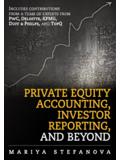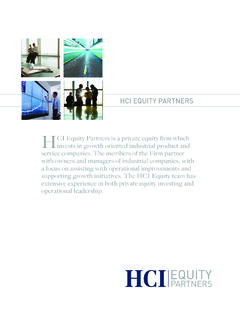Transcription of World Development Report 2006
1 The World Bank July 2004 This document can be downloaded from , under WDR 2006 , Outline. World Development Report 2006 equity and Development Table of Contents 0. Overview: introduction and summary Part I: How unequal is the World ? 1. Inequalities within countries: people and groups 2. Global inequalities: countries and people Part II: Does inequality matter? 3. equity , well-being, and Development 4. Inequalities and investment 5. Inequalities, power and conflict Part III: Institutions and policies for greater equity and lower poverty 6. equity and economy-wide processes and policies 7. Towards equity in assets, incomes and agency 8. Institutions and policies for global equity Report Outline 0. Overview: Introduction and Summary The average level of real income in the richest countries is 50 times that of the poorest.
2 The richest tenth of the South African population enjoy levels of consumption per person almost 70 times those of the poorest tenth. In Brazil, whereas adults in the richest fifth of the population have years of schooling on average, those in the poorest fifth have 3 years. In India, under-five mortality rates are 155 per thousand live births for the poorest twenty percent or the population (in wealth terms), compared with 54 for the richest quintile. Citizens of the World also experience profound differences in influence, access to legal systems, power and social status, whether at the level of individuals, between men and women, or between groups. Acute inequality in incomes, in health status, in educational outcomes and in other dimensions of welfare is a stark fact of life.
3 Its resilience in individual countries and in the World is often seen as the sign of the failure of past and present economic systems to bring about Development for all and the abolition of poverty. This WDR will explore the relationship between equity and Development strategy. In doing this it will build on and extend existing frameworks. equity is a potentially important factor affecting both the workings of the investment environment and the empowerment of the poor the two major lines of the World Bank s poverty reduction There are powerful links with the accountability framework for service delivery that was the central focus of the 2004 WDR. And the forthcoming social Development strategy, that is organized around themes of social inclusion, cohesion and accountability is intimately concerned with issues of equity as we plan to use the term in this Report .
4 What is meant by equity ? equity is explicitly about normative concerns of fairness and social justice. There are many moral approaches to this. We currently plan to organize primarily around a conception of equality of opportunities, or, more broadly, equality in the capability (or freedom) of different individuals to pursue a life of their This will also take us to consider inequalities in recognition, where different groups (women, ethnic, caste etc.) face different opportunities owing to differences in their status, power and influence within a society. equity in this sense generally does not imply equality in outcomes (such as in incomes or consumption). Even an exclusive concern with equity would lead to differences among individuals, since individuals differ in needs, preferences, efforts and talents.
5 Moreover, a concern with equity and the means to achieve it has to be balanced against other objectives, such as respect for personal 1 This strategic framework itself builds on the WDR 2000/01 s trilogy of opportunity, empowerment and security. The investment environment is the focus of WDR 2005. See the references at the end for the some of the key World Bank documents. 2 See Sen (1992) 2freedoms, or the provision of incentives for efficient resource use, entrepreneurship, innovation, saving and investment, with which there may or may not be tradeoffs. 3 Why is equity central to poverty-reducing Development ? There are two fundamental reasons. First, inequalities in opportunity or capabilities can be a profound source of poverty, both within societies and across nations.
6 Poor people are poor because of inadequate access to schools, health centers, roads, market opportunities, credit, effective risk-management mechanisms and so on. These are in turn typically associated with inequalities of voice or influence both in the shaping of policy and in its effective implementation. Second, reduction in poverty (in incomes, education, health etc.) is a product of both aggregate Development and its distribution. The fact is that there are potentially important interactions between the policies and institutions for dealing with equity and such aggregate Development processes, including both the level of economic growth and its distribution. This can sometimes involve tradeoffs, as noted above. But this is by not always necessarily the case, especially over time.
7 At a national level all currently developed societies historically put in place policies and institutions to provide for equity , in areas that included education provision, risk management and equality before the law. This was at least consistent with the achievement of levels of prosperity unprecedented in human history. At a more micro level, some areas of lack of equity for example customary restrictions on girls schooling, the household allocation of labor between men and women or access to credit have been shown to be potentially bad for economic efficiency and growth. The central challenge for this Report will precisely be an assessment of how equity affects poverty reduction via both its effects on distribution and on overall Development processes, at local, national and global levels.
8 While the fundamental concern is with equity , empirical investigation will have to rely heavily on measurable inequalities in a variety of outcomes, backed by interpretation of the relationship with equity . Indeed, practically and operationally, the concepts of equity and equality overlap quite extensively. For instance, income differentials between rich and poor countries are roughly commensurate with differences in the opportunities and capabilities of their citizen. These are in turn both associated with and affected by inequalities in influence on global policies and developments. Likewise, analyzing empirically differences in opportunities and capabilities within a society requires considering the inequalities that shape individuals access to opportunities education, health, parents' wealth and their outcomes such as income and consumption.
9 The overall purpose of the WDR is to provide policy advice. But to provide the foundation for this, we need to document patterns of inequalities and the reasons why some inequalities may be of concern for Development . Thus our approach is threefold. First, in Part I, we seek to describe patterns of inequality in a range of variables relevant to a concern with equity both at the national and global level incomes, educational achievements, health indicators, power and influence. Then, in Part II, we highlight a set 3 This view is articulated by Cohen (1993), (we) take for granted that there is something which justice requires that people have equal amounts of, not no matter what, but to whatever extent is allowed by values which compete with distributive equality (Cohen, 1993, , emphasis added).
10 3of reasons why some levels of inequality in the preceding variables may be too high, whether for intrinsic reasons, or because they actually harm the attainment of other competing values, such as the absolute levels of material goods and services available in an economy. Finally, in Part III, we discuss policies that affect the relationship between equity and the Development process, at a country and global level including policies that could help reduce the levels of some intermediate inequalities focusing especially on circumstances in which this is likely to form the basis for more rapid overall Development and faster poverty reduction. Both the second and third parts of the Report will pay particular attention to how inter-relationships between equity and overall Development processes (of which aggregate economic growth is one) are likely to affect poverty reduction.














![Employment Equity Act [No. 55 of 1998] - Welcome …](/cache/preview/d/d/0/6/0/9/b/f/thumb-dd0609bf308cea3d6ac0c26c1659c10d.jpg)
